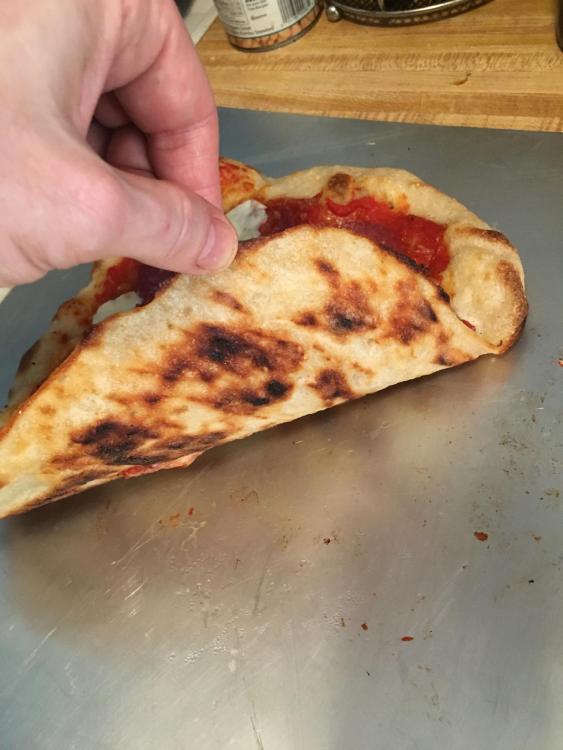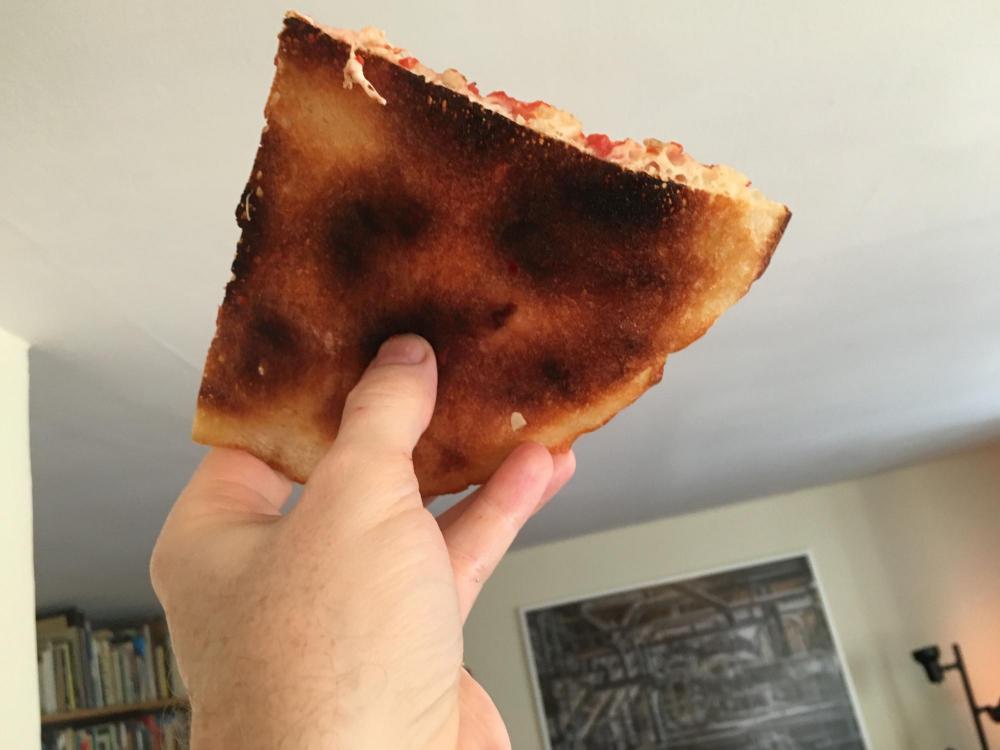-
Posts
5,173 -
Joined
-
Last visited
Content Type
Profiles
Forums
Store
Help Articles
Everything posted by paulraphael
-
I always start dough with the flat beater. This includes the initial mixing before autolyse, and the wet mixing before adding the final quantity of flour. It's much faster and works the dough much harder than a dough hook can. Once the dough develops some body switch to the hook (mandatory ... you'll break something if you don't).
-
I'd never get an extended warranty. I do the opposite and buy them refurbished, which saves a ton of money (in exchange for a 6 month warranty). Which is fine if you use it a lot ... you'll know in a couple of months if anything's wrong with it. Now that I know how easy they are to work on, I'd take the thing apart and regrease it the minute the warranty's up.
-
All the parts came in and got the beast put back together again. It was unclear what caused the binding, since the only gear wear I found was minor, and none of it was in the planetary housing (which is what was getting stuck). The shaft that attaches the planetary to the gearbox was loose. It could have been that, or it could have been dried grease that assembly. Anyway, I replaced the slightly worn gears (unnecessary but cheap) and the planetary assembly. Then I gave the machine its big upgrade with the synthetic grease. No chance yet to use it, but unloaded it sounds quieter and smoother than ever. It's nice knowing that I'll never have to worry about the grease separating again from disuse or heat. And I won't have to worry about using the mixer hard when it's cold or has been sitting a long time. At least in theory.
-
There's an advantage for things that draw a lot of power, like espresso machines and induction hobs. The assumption with appliances sold in the U.S. is that most houses have at least some 15 amp circuits, so standard appliances are limited to 1800 watts—and then only rarely, because they wouldn't be able to share the circuit with anything. Some heavier duty things come with plugs for special 20 amp outlets. These are one-outlet-per-circuit arrangements that take air conditioner plugs, and can handle appliances up to 2400 watts. In the UK and France, the standard is 230v (it can vary by 10%, so people call it 220), with 13 amp circuits. This means any outlet in a non-ancient building can handle over 2800 watts. So appliances can be made more powerful. Great if you want a professional espresso machine. Irrelevant with mixers, unless you need a Hobart that's big enough to climb inside.
-
Probably mentioned upthread, but I can't speak highly enough of cutting boards by The Boardsmith. All made in a workshop by one guy who's a pleasure to deal with, does great work, and has seriously researched the topic. And he undercharges. I've had a 16x22 maple end grain board of his for eight years or so, and it's nicer than new. Hasn't yet needed sanding (although I cut with a light touch and don't use my serrated bread knife on it). All his boards have rubber feet on the bottom, which is such a good idea I've applied it to my other wooden boards. The feet prevent slipping, and more importantly, keep moisture from accumulating under the board. This is the classic cause of boards warping and developing a concave surface.
-
A cheap one. Definitely not what I use for finer cutting. Most butcher shops these days use poly boards and throw them out when they get too hacked up. If you look at the end-grain blocks used traditionally by butchers, they all had hills and valleys from the constant sanding needed to keep the surface free of grooves. I don't use my end-grain board like this—I want it to stay flat.
-
Exactly. Wondra's also ideal for breading things you're going to sauté.
-
I usually advise people in the U.S. to get KA, and people in Europe to get Kenwood. If you read a lot of reviews, you find similar strengths and weaknesses among them. But one of the greatest strengths of each is the parts and service network on its respective continent. Hard to get Kenwood service here, hard to get KA service there. My KA project is relatively cheap and easy only because I'm in the U.S.. I'm aware that the Cuisinart mixer is a version of the Kenwood (as is the viking and I believe the delonghi), but it has not gotten the best reviews here, at least if you're not comparing one of KA's mistakes, like some of their models from the late 90s / early 2000s. I don't know if the Cuisinart is identical to the best models Kenwood sells overseas.
-
Something I just noticed: the motor in the pro 600 is labelled "Ankarsrum," which you might recognize as the Swedish company that makes the Electrolux mixers (which are always getting pitted against the KA mixers in reviews). You might be getting the same motor in each machine. Vitamix switched to a Swedish-made motor a few years ago also.
-
I'm experimenting with 65% on the next batch. Today I used the second half of my my batch of glue dough. While preheating, I figured out that my temperature readings have been wrong. The IR thermometer was picking radiant heat reflected off the broiler, and was telling me the steel was 200F high. If I pulled out the broiler drawer and took a reading, it wouldn't get above 450F or so, even long past an hour. So I took the hot, 32lb steel and stuck it on a rack 7" from the top of the oven (not recommended!). Here with the oven on full blast it got to about 560F in the middle. I managed to get the dough proofed more thoroughly this time. And with an extra 3 days of retarding in the fridge, the flavors intensified. This round was a big improvement. The pies still took 6 minutes, but they developed nice char on the bottom, even through the parchment, and puffed up with more oven spring than I'd been able to get in previous years with a stone. The crust was airy and moist, with good chew. Next time I'll try moving the steel a notch up to the highest position. And I'll see if I can get the same airiness with a lower hydration dough. This one I tried baking on foil instead of parchment. Bad idea. Char was a bit odd and the foil glued itself to the bottom, even though it had been oiled.
-
Ha. I'll just point you to a video. If you can bake a cake you can fix a stupid mixer!
-
After 8 years i've finally had a problem with my pro 600. I've been experimenting with pizza, and working with stiffer doughs, and yesterday I got some binding and bad noises from the planetary assembly. I'm waiting for a set of snap-ring pliers to show up so I can complete the disassembly and figure out what's going on. So far i have the gear cover open and the worm assembly gears removed and everything on top cleaned up. I'm more impressed with this mixer than I was before breaking it(!) The gears are very high quality and the machining tolerances look better than I expected. After 8 years there is no visible wear anywhere, and the grease is in good shape. I'm not sure what's going down below in the planetary assembly, but clearly that's where the problem is. It's also the part of the mixer that has made inconsistent noises in the past. I may find a worn/broken gear, a worn bushing, or something similar. The best news is that these machines are extremely easy to work on, parts are available everywhere (do some comparison shopping ... prices vary a lot) and there are instructional videos online that show you in about 10 minutes how to completely overhaul them. To save time, I ordered a whole new planetary assembly. It cost about $25. Buying the replacement gears and washers cost about the same amount, so I decided to keep it simple. You need to get a new gasket for the gear housing. About $6 including shipping. If you have an old style plastic housing, you should use this opportunity to upgrade to the indestructible magnesium one. It's a pop-in replacement. You also need to replace the grease. KA uses and specifies their own food-grade grease (which is probably a Shell product). This is one of the weakest links in the whole mixer. It's a poor quality grease by modern standards. It hardens (which stops it from working) and it separates (which leads to the liquid portion leaking out into your merengue). I upgraded to a synthetic #2 grease called Superlube; there are other similar ones. It's food-grade, odorless, impervious to salt and water, safe on rubber and plastics, is completely stable, and has a temperature range nearly 200 degrees broader than the KA grease. People online have said the synthetic greases makes their mixers run more smoothly and quietly. People have also reported that they've discovered inadequate lubrication when opening their mixers ... like a top bushing or planetary gear that not been given enough grease, or in some cases that hadn't been greased at all. It's possible I'll find something like this. This is going to be about $75 worth of maintenance after 8 years of pretty hard use. I anticipate that the mixer will run better than new when fixed and packed with the synthetic grease. The most expensive part of this was the snap-ring pliers ... if you have a pair you're set. If you're shopping for them, be careful—most are too big for the rings on the mixer. I'd also suggest getting some good-quality non-toxic degreaser. You want to get everything squeaky clean before putting in the new grease. Overall, I'd say that fixing a pro-600 is a bit easier than working on a racing bicycle, a bit harder than assembling an Ikea coffee table.
-
Escoffier also predicted that one day we'd have much better thickeners than flour I like his recipes as a reference, but for anything like sauces, stocks, glaces etc., I think of them as historical curiosities. We have techniques now that will give better flavor and clarity with less time investment and much less waste. I like roux in certain dishes where it's part of the local character, like gumbo. But I wouldn't assume that there's any important difference between the flour you can get and whatever E. used. The chemistry of roux is such that you're basically clarifying the wheat starch. The butter is a cooking medium, and whatever starch you don't transform by browning gets dispersed and forms a hydrocolloid with the water. The protein separates, cooks, clumps together, and joins the scum on top. So it really doesn't matter if you're using flour that's 9% protein or 14%. If you're making a cake that's success vs. failure, but with roux none of it's going to be in your finished product.
-
Thank you ... I agree it looks pretty good, but the eating was only so-so. And yeah, this dough is sticky beyond what you can solve with cornmeal. It's like a gelatinous blob of glue. For my next batch with 65% or so hydration I'll try sliding it.
-
Don't bother trying to get 00 pizza flour. It's only of interest if you're baking at 800°F or higher, which is done in the interest of Neapolitan-style crusts, not crisp ones. At lower temperatures and longer cooking times 00 offers no advantages, and may contribute to problems. I don't think the type flour matters nearly as much as the hydration and the way you hydrate it and develop the gluten. Crisp crusts are generally the product of the crust drying out over a longer cooking time. When you try to make Neapolitan pizzas in oven that isn't hot enough, you get crispy crusts. I'd think that some added sugar in the dough might help exaggerate this effect.
-
Wondra is designed to thicken sauces without any requirement for it being cooked. It won't give you the raw flour flavor that you'd otherwise get (which is actually the flavor of partially cooked flour ... raw flour is pretty tasteless). And since the starch has be pre-gelatinized, it will dissolve easily and have full thickening power right away. It's basically so you can use wheat flour the same way you'd use a purified starch, like corn starch or arrowroot. Since the whole process of making roux, including skimming the released fat, will fully cook and gelatinize any flour, I'm not sure what advantage you'd see from wondra. My inclination would be to go for lower protein flours, rather than higher, since the proteins in the flour just contribute to the scum that you have to skim off. But really, whatever flour you have will work fine. How are people getting lumps in their roux? I've never noticed a tendency for flour form lumps that the requisite whisking wouldn't take care easily enough. Roux should be pretty foolproof. The only thing to keep in mind is that the darker you brown it, the less thickening power it will have.
-
We just made our first two pizzas on the 1/2" steel in the broiler. Results were ok for a first try, but a fail if comparing to a couple of the wood oven places within 20 minute's walking distance, and embarrassment compared to the best Brooklyn has to offer. I think we can get in the ballpark of the former; probably not the latter. I made the mistake of dropping the broiler rack to the 2nd position, out of fear that the pizza would combust if any closer to the fire (I once sent a ball of flame all the way to the ceiling from the nachos I pulled out of a similar broiler. Made me shy). Because of the added distance, the stone only got up to 540°F or so, and the pizzas took a full 6 minutes. I'd like to get it under 4 minutes. I also cooked the pizzas on parchment, which I find necessary when working with very high hydration doughs. These crusts were about 75% hydration before any added bench flour, and were like glue. It's beyond my art to slide this kind of dough off a peel. I suspect that if we can get the temperatures above 600F and the time down significantly, we'll be able to use lower hydration and then dispense with the parchment. All together this might help get some char on the bottom. Right now we're working with commercial yeast and delayed fermentation (to get some flavor). Once we get the mechanics down we'll get a sourdough starter going. Our favorite pizzas are quite sour.
-
I contacted a few metal fabricators / scrapyards in the NYC area, and was quoted outrageous prices every time. So that led to shopping for the pre-packaged solutions. I decided to go for a 1/2" steel based on the slight thermal advantages, and since my back is ok. It came to a choice between ones by Dough Joe and by Nerd Chef. With shipping they each come to about $100, either from Amazon or direct from the companies. The Dough Joe is 15" square and would be ideal for using in charcoal grill or kamado. I went with the slightly more rectangular Nerd Chef because it has a couple of big finger holes to make it easier to handle. I assume there would be zero performance difference. In a trial run with my stove (one of those very cheap NYC apartment gas ranges that has a broiler compartment below the oven and no electronics). On the top shelf the steel got to about 510F in 1 hour. It might have gone higher but I ran out of time. More interestingly, the broiler rack down below got up to 640F. These cheap ranges use the same heating element for the oven and for the broiler, which might make them ideal. So for pizza test 1 today, I'm going to try the broiler shelf. I'm not sure if I'll leave the broiler element on for the whole duration of the cook ... that seems like it might set things on fire. Unfortunately there's no way to watch, so it will take some winging it.
-
I used to cook risotto in any old pan. If you're doing it traditionally, the pan makes virtually no difference, because you never stop stirring. I've used heavy aluminum, which heats very evenly, and enameled cast iron, which does not. Same results. And you don't need fast temperature response for risotto. Just the occasional small adjustment to keep things simmering at about the right rate. A fairly wide pan might help things go faster, since it speeds evaporation. Nowadays I always do risotto in a pressure cooker. So much faster than the traditional method, and no tradeoffs. I haven't tried using the fuzzy rice cooker. Not sure what the workflow would be, or the settings on the machine. With a pressure cooker, you use it as a stockpot when sweating the arromatics, cooking down mushrooms, etc., and then pressurize to cook the rice. I usually undercook slightly under pressure, so I can finish to the exact right consistency while stirring. This finishing step just adds a couple of minutes.
-
I really wouldn't worry about the legal implications of distilling spirits in a rotovap. While the law is quite clear here (distilling even a teaspoon of booze is verboten) who's going to know or care if it's for personal use? With the quantities you can handle in a vap, you're probably not going to be distilling anything for a group bigger than a dinner party. Smoking weed at home seems riskier. A friend and I looked into getting one and getting a microdistilling license (this is relatively now compared with years past). The plan was thwarted when I figured out how small the batches would be and how long each one would take. It's a lab tool, not a production tool.
-
Why not add a large hadron collider to the wish list? The cool kids are only doing quantum gastronomy these days. Seriously, I'd second that the centrifuge is probably more practical. I've been dying to play with a rotovap, and seriously investigated one once, but they're very big and very fragile, and it seems unwise to buy a used one unless you 100% know what you're doing, which was far from my situation. And new ones of course cost a bundle.
-
I'm reviving this thread after a lot of years, this time because we're actually shopping for new counters. We're not trying to spend huge money, so some of the more interesting options (like Dekton and other sintered surfaces) are off the table. So to speak. It looks like I was wrong about the lab countertops—they're pure epoxy resin. Not quartz bound by epoxy. I'm still interested, though. I saw a picture of a kitchen on Garden Web with all lab epoxy and it looked great. I'm just concerned about scratching. Most of what I read suggests you can't sand deep scratches out of the stuff. It's not a functional issue, but considering we're doing this in part to make the place more sellable, it's not a problem we're looking for. We're open to the various quartz/resin materials also, but don't want to spend $100/square foot. If there's anything good for half that price we'd love to know.
-
Has anyone tried a steel in one of those ovens that has a separate broiler compartment? The thing that looks like a drawer below the main oven chamber?
-
My impression with CI is that they always suggest that they're an authority. It's partly their tone, and partly that they don't make the effort to acknowledge the limitations (or even the subjective nature of the choices) in whatever tests they're doing.
-
Sure, if you're doing your own tasting for yourself. But if you're going to publish a review, especially one with the air of authority that CI assumes, I think you should do your homework. Just like with wine, not everyone is going to like what the trained tasters like. There are recognized flaws wine that some people specifically enjoy, like taint from brettanomyces yeast. But it's irresponsible to print a review that goes counter to the industry standards without acknowledging it. CI was recommending oils that had rancidity flaws—not because they were championing a controversial position, but because they had absolutely no idea. Which means they had so much confidence in their own imagined authority, that they didn't even bother to ask anyone who knew anything. So looking at something like saucepans, why would I trust that anyone there actually knows anything about saucemaking? It's a craft I studied for years—the only meaningful opinions I have about saucepans are rooted in that knowledge. Without it, you'd easily arrive at very mistaken conclusions about what's important, or you'd subscribe to the usual lore, like "use a heavy thick-bottomed pan ..." How many times have we heard that? Advice like this could lead us to sauciers made from enameled cast iron, or ones with a 10mm aluminum disk on the bottom, both of which would be terrible. Useable—because you can make anything work—but definitely the most difficult to use.








